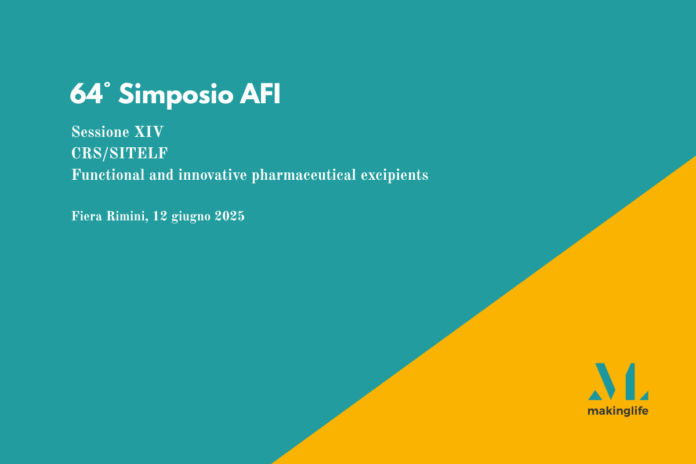Excipients, long considered supportive elements in pharmaceutical formulations, are undergoing a true evolution in both role and perception within the pharmaceutical sciences landscape. No longer merely “inert” vehicles for active ingredients, they have become central players in optimizing the therapeutic performance of medicines by supporting stability, bioavailability, and precise release. This new centrality is the focus of Session XIV of the 2025 AFI Symposium, an event that brings together the Controlled Release Society Italy Local Chapter and SITELF (Italian Society of Pharmaceutical Technology and Legislation), under the leadership of Stefano Salmaso and Bice Conti, moderators of the session.
As Stefano Salmaso explained in the presentation video, the session will offer an in-depth and multidisciplinary discussion, involving excipient manufacturers, academic and industrial researchers, and representatives from AIFA. This exchange aims not only to showcase ongoing innovations, but also to explore the regulatory and clinical challenges that are shaping the future of the sector.
Excipients: from “filler” role to therapeutic strategy
Traditionally, excipients were considered “inert” substances that provided form and stability to pharmaceutical formulations—think of tablets, capsules, injectables. However, with the evolution of clinical needs and pharmaceutical technologies, this role has profoundly changed. Excipients today are critical for the final characteristics of a medicinal product: from immediate or modified release of active ingredients to chemical-physical stability, and even absorption through complex biological barriers such as the gastrointestinal tract or the blood-brain barrier.
In this context, excipients can influence pharmacokinetics—that is, how a drug is absorbed, distributed, metabolized, and eliminated—and therefore its therapeutic effectiveness. “In some cases, it is the excipients themselves that determine whether an active ingredient can evolve into a competitive medicinal product or not,” emphasized Salmaso. This paradigm shift is also redefining the research and development priorities of pharmaceutical companies.
A growing market driven by innovation and reformulation
The economic size of the sector reflects the increasing importance of excipients. According to recent estimates, the global excipient market will reach 15 billion dollars by 2030. This trend concerns not only new active pharmaceutical ingredients but also the reformulation of existing drugs, an area that extends the product lifecycle of branded drugs and creates value in highly competitive environments.
Not surprisingly, research on excipients has become one of the main strategic levers for the industry. The goal is to develop controlled-release systems that can overcome biological barriers and improve patient adherence—an essential factor in chronic treatments and among elderly populations. In this sense, Session XIV of the AFI Symposium stands as a key moment to discuss the new frontiers and challenges that the pharmaceutical industry must address.
From basic science to regulation: an open debate
The program of Session XIV aims to cover the entire span of excipient innovation, from design to production, through to clinical applications and regulatory issues. In particular, it will delve into:
-
Emerging technologies in excipient design, focusing on how they affect drug bioavailability and stability.
-
Advanced delivery systems, essential to ensure optimal dosing and reduce administration frequency, improving treatment adherence.
-
Strategies to enhance absorption through biological barriers—one of the main challenges for oral (and beyond) administration.
-
The regulatory perspective, represented by AIFA, which will provide an updated framework on the quality standards and regulations required for excipients.
This integrated vision, which brings together science, industry, and regulation, is crucial for tackling the challenges of the next decade. Excipients are set to play an increasingly central role in ensuring medicines that are more effective, safer, and more accessible.
The importance of multidisciplinarity and interaction
Another aspect highlighted by Salmaso is the desire to create an interactive and constructive exchange among all the players involved. In fact, the session is not limited to a series of presentations, but aims to be an opportunity to connect expertise and foster collaborations between academia and industry. “We want to build a dialogue that generates new ideas and concrete projects,” said Salmaso, inviting both academic researchers and R&D professionals to participate.
The objective is twofold: on the one hand, to bring out innovative solutions that can translate into real clinical benefits; on the other, to create a collaborative ecosystem that takes into account the global challenges—such as sustainability and access to medicines—that are reshaping the pharmaceutical landscape.
An “engaging and inspiring” session to shape the future
Salmaso’s final message is clear: Session XIV aims to be a moment of inspiration and future-building. It is no coincidence that Salmaso spoke of an “engaging and inspiring” session—words that resonate with the vision of a pharmaceutical industry increasingly integrated and attentive to innovation in every component, including excipients.
With the rise of personalized therapies, controlled-release formulations, and biotechnologies, the ability to design and use smart excipients is becoming a differentiating factor. Session XIV represents a unique opportunity to delve deeper into these topics in a high-profile scientific context with an international perspective.
In a world where the boundaries between basic science, applied research, and clinical needs are increasingly blurred, excipients are emerging as key elements for bringing innovation from the lab to the patient. It is precisely through the valorization of excipients that a significant part of the future of the pharmaceutical industry takes shape.


